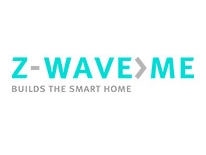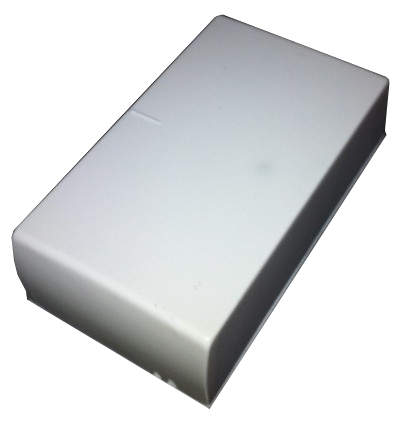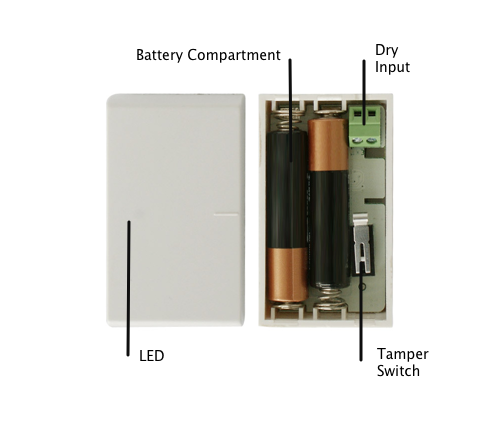
Z-Wave.Me
Binary Sensor, Thermostat for Heating and Cooling and Temperature Sensor
SKU: ZME_MBINAR

Quickstart
This is a
A tripple click on the tampering switch behind the battery cover within 1.5 seconds will confirm standard inclusion and exclusion, double click confirms network wide inclusion. A single click on the same switch will wake up the device and keeps it awake for 10 seconds.
Important safety information
Please read this manual carefully. Failure to follow the recommendations in this manual may be dangerous or may violate the law. The manufacturer, importer, distributor and seller shall not be liable for any loss or damage resulting from failure to comply with the instructions in this manual or any other material. Use this equipment only for its intended purpose. Follow the disposal instructions. Do not dispose of electronic equipment or batteries in a fire or near open heat sources.What is Z-Wave?
Z-Wave is the international wireless protocol for communication in the Smart Home. This device is suited for use in the region mentioned in the Quickstart section.
Z-Wave ensures a reliable communication by reconfirming every message (two-way communication) and every mains powered node can act as a repeater for other nodes (meshed network) in case the receiver is not in direct wireless range of the transmitter.
This device and every other certified Z-Wave device can be used together with any other certified Z-Wave device regardless of brand and origin as long as both are suited for the same frequency range.
If a device supports secure communication it will communicate with other devices secure as long as this device provides the same or a higher level of security. Otherwise it will automatically turn into a lower level of security to maintain backward compatibility.
For more information about Z-Wave technology, devices, white papers etc. please refer to www.z-wave.info.
Product Description
This product is a combination of a binary sensor with external switches, temperature sensor and a thermostat controlling a remote heating device by comparing the target temperature set with the measured temperature. The three functions can be used in parallel or independent of each other. The temperature sensor has a high accuracy +/- 0.2 K. The device is battery operated and can be placed on every flat surface either using screws or double sides tape.
Prepare for Installation / Reset
Please read the user manual before installing the product.
In order to include (add) a Z-Wave device to a network it must be in factory default state. Please make sure to reset the device into factory default. You can do this by performing an Exclusion operation as described below in the manual. Every Z-Wave controller is able to perform this operation however it is recommended to use the primary controller of the previous network to make sure the very device is excluded properly from this network.
Safety Warning for Batteries
The product contains batteries. Please remove the batteries when the device is not used. Do not mix batteries of different charging level or different brands.
Installation
The devices cover can be mounted on every flat surface either using two screws or strong double sides type. Insert both the batteries (2 x AAA) into the battery case while paying attention to the indicated plus (+) / minus (-) poles. The MBINAR can now be mounted. The device itself is then just pushed on the cover. Make sure the dry input terminals match with the little spacing on the edge of the cover part.

Attention: The electronic circuit of the MBINAR can be damaged in the case of wrong insertion of batteries.
Inclusion/Exclusion
On factory default the device does not belong to any Z-Wave network. The device needs to be added to an existing wireless network to communicate with the devices of this network. This process is called Inclusion.
Devices can also be removed from a network. This process is called Exclusion. Both processes are initiated by the primary controller of the Z-Wave network. This controller is turned into exclusion respective inclusion mode. Inclusion and Exclusion is then performed doing a special manual action right on the device.
Inclusion
Once the controller is turned into standard inclusion mode tripple click the tamper switch will include the device. In case the controller is in network wide inclusion mode a double click will confirm inclusion. In case of doubt about the type of inclusion please assume standard inclusion.
Exclusion
Once the controller is turned into standard inclusion mode tripple click the tamper switch will include the device. In case the controller is in network wide inclusion mode a double click will confirm inclusion. In case of doubt about the type of inclusion please assume standard inclusion.
Product Usage
The temperature sensor function (communication pattern 3) can be used without any further installation or configuration. The binary sensor function is available on the two terminal blocks inside the device. Please wire these terminals to the external switch that can be used. Beware: You must not power the two terminals. They are only connected with an external switch that is connecting the two wires or not. Switching the binary input can be used to control a wireless actor using Z-Wave commands (communication pattern 4).
The device can be used as a room thermostat. This function monitors the measured temperature against a desired temperature set point or a temperature range defined by a lower and an upper temperature trigger. The setpoint temperature can be set wirelessly using a Z-Wave command (Command Class Temperature Setpoint) MBINAR will send on and off commands to a wirelessly controlled heating device (communication pattern 4) to keep the temperature within the desired range. Please refer to the description of the configuration parameters 1,2,4 and 5 for more information how to control wireless devices and how to set a desired temperature range.
To gain higher accuracy with the temperature sensor the device can be calibrated.
Node Information Frame
The Node Information Frame (NIF) is the business card of a Z-Wave device. It contains information about the device type and the technical capabilities. The inclusion and exclusion of the device is confirmed by sending out a Node Information Frame. Beside this it may be needed for certain network operations to send out a Node Information Frame. To issue a NIF execute the following action:
A single click on the tampering switch behind the battery cover will send out a Node Information Frame.
Communication to a Sleeping device (Wakeup)
This device is battery operated and turned into deep sleep state most of the time to save battery life time. Communication with the device is limited. In order to communicate with the device, a static controller C is needed in the network. This controller will maintain a mailbox for the battery operated devices and store commands that can not be received during deep sleep state. Without such a controller, communication may become impossible and/or the battery life time is significantly decreased.
This device will wakeup regularly and announce the wakeup state by sending out a so called Wakeup Notification. The controller can then empty the mailbox. Therefore, the device needs to be configured with the desired wakeup interval and the node ID of the controller. If the device was included by a static controller this controller will usually perform all necessary configurations. The wakeup interval is a tradeoff between maximal battery life time and the desired responses of the device. To wakeup the device please perform the following action:
MBINAR is awake right after inclusion for 2.5 seconds allowing the controller to perform certain configuration. It is possible to manually wake up the device by pushing the tamper switch. MBINAR will accept wakeup intervals between 4 minutes and 180 days.
Quick trouble shooting
Here are a few hints for network installation if things dont work as expected.
- Make sure a device is in factory reset state before including. In doubt exclude before include.
- If inclusion still fails, check if both devices use the same frequency.
- Remove all dead devices from associations. Otherwise you will see severe delays.
- Never use sleeping battery devices without a central controller.
- Dont poll FLIRS devices.
- Make sure to have enough mains powered device to benefit from the meshing
Association - one device controls an other device
Z-Wave devices control other Z-Wave devices. The relationship between one device controlling another device is called association. In order to control a different device, the controlling device needs to maintain a list of devices that will receive controlling commands. These lists are called association groups and they are always related to certain events (e.g. button pressed, sensor triggers, ...). In case the event happens all devices stored in the respective association group will receive the same wireless command wireless command, typically a 'Basic Set' Command.
Association Groups:
| Group Number | Maximum Nodes | Description |
|---|---|---|
| 3 | 5 | Nodes to receive updates on thermostat set point change and binary reports |
| 2 | 5 | Nodes to be controlled by thermostat |
| 1 | 5 | Nodes to be switched on/off on dry contacts switch |
Configuration Parameters
Z-Wave products are supposed to work out of the box after inclusion, however certain configuration can adapt the function better to user needs or unlock further enhanced features.
IMPORTANT: Controllers may only allow configuring signed values. In order to set values in the range 128 ... 255 the value sent in the application shall be the desired value minus 256. For example: To set a parameter to 200 it may be needed to set a value of 200 minus 256 = minus 56. In case of a two byte value the same logic applies: Values greater than 32768 may needed to be given as negative values too.
Parameter 1: Binary sensor active
defines of the binary sensor is active Size: 1 Byte, Default Value: ff
| Setting | Description |
|---|---|
| 00 | Off |
| ff | On |
Parameter 2: Binary sensor mode
defines the command sent when the binary sensor is triggered Size: 1 Byte, Default Value: 00
| Setting | Description |
|---|---|
| 00 | Basic On on connected, Basic Off on diconnected |
| ff | Basic Off on connected, Basic On on diconnected |
Parameter 3: Send Unsolicited temperature report
Threshold temperature to send unsolicited report. 10 = 1 u00b0C Size: 1 Byte, Default Value: 00
| Setting | Description |
|---|---|
| 00 | Disabled |
| 05 - 32 | in 0.1 u00b0C |
Parameter 4: Maximum deviation for thermostat
Maximum deviation (threshold) of temperature from set point before switching on/off cooling/heating for thermostat. 10 = 1 u00b0C Size: 1 Byte, Default Value: 0a
| Setting | Description |
|---|
Parameter 5: Repeat thermostat ON
Repeat thermostat events (switch ON events only) periodically Size: 1 Byte, Default Value: 00
| Setting | Description |
|---|---|
| 00 | Send only once |
| 01 - ff | each Nth wakeup time |
Parameter 6: Unsolicited temperature report period
Size: 1 Byte, Default Value: 00
| Setting | Description |
|---|---|
| 00 | Off |
| 01 - ff | each Nth wakeup time |
Parameter 7: Temperature shift
Threshold correction. For positive value 10 = 1 u00b0C, for negative value x = 256 - (Tu00b0C * 10). Example, if need shift -2u00b0C, value calculate: 256 - (2 * 10) = 236. Size: 1 Byte, Default Value: 00
| Setting | Description |
|---|---|
| 00 | Disabled |
| 01 - 7f | in 0.1 u00b0C |
| 7f - ff | in 0.1 u00b0C |
Parameter 30: Send unsolicited Battery Report on Wake Up
Size: 1 Byte, Default Value: 00
| Setting | Description |
|---|---|
| 00 | No |
| 01 | To wakeup node |
| 02 | To broadcast |
Technical Data
| Dimensions | 0.0030000x0.0050000x0.0010000 mm |
| Weight | 20 gr |
| Hardware Platform | ZM3102 |
| Battery Type | 2 * AAA |
| Device Type | Routing Binary Sensor |
| Generic Device Class | Binary Sensor |
| Specific Device Class | Routing Binary Sensor |
| Firmware Version | 02.01 |
| Z-Wave Version | 03.43 |
| Z-Wave Product Id | 0115.0201.0003 |
| Frequency | Europe - 868,4 Mhz |
| Maximum transmission power | 5 mW |
Supported Command Classes
- Battery
- Thermostat Mode
- Thermostat Setpoint
- Wake Up
- Association
- Version
- Basic
- Configuration
- Sensor Multilevel
- Manufacturer Specific
- Sensor Binary
- Node Naming
- Multi Channel Association
- Multi Channel
Controlled Command Classes
- Basic
- Multi Channel
Explanation of Z-Wave specific terms
- Controller — is a Z-Wave device with capabilities to manage the network. Controllers are typically Gateways,Remote Controls or battery operated wall controllers.
- Slave — is a Z-Wave device without capabilities to manage the network. Slaves can be sensors, actuators and even remote controls.
- Primary Controller — is the central organizer of the network. It must be a controller. There can be only one primary controller in a Z-Wave network.
- Inclusion — is the process of adding new Z-Wave devices into a network.
- Exclusion — is the process of removing Z-Wave devices from the network.
- Association — is a control relationship between a controlling device and a controlled device.
- Wakeup Notification — is a special wireless message issued by a Z-Wave device to announces that is able to communicate.
- Node Information Frame — is a special wireless message issued by a Z-Wave device to announce its capabilities and functions.